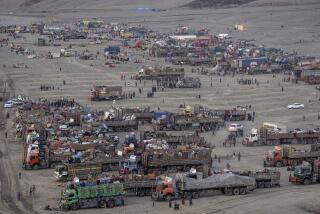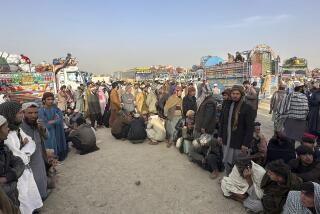Pakistani tribe rooting for military
- Share via
BHAKKAR, PAKISTAN — The Mahsud tribesmen of South Waziristan don’t hate the Taliban. But they hate what having Taliban fighters living among them has done to life in their mud-hut hamlets.
The Taliban presence has made their villages frequent targets for U.S. missile strikes. It has prevented schools and hospitals from opening and roads from being built. Many villages still do not have electricity or phone lines.
As people stream out of South Waziristan to escape the all-out blitz against the Taliban, they say they back the offensive, if only because it represents their best -- and only -- hope for a clean break from the misery of isolation.
“Though we weren’t directly threatened by the Taliban, all of the hardship and suffering we face is because of the militants,” says Ali Khan, 33, a shopkeeper from the Taliban-ridden village of Makeen. “When these militants go, we expect schools to start up. We want to live the life that’s led elsewhere in Pakistan.”
As many as 155,000 people in South Waziristan have fled the fighting as 30,000 Pakistani troops take on an estimated 10,000 Taliban militants entrenched in concrete bunkers and networks of caves and tunnels built into the region’s desolate plateaus and mountainsides.
The Mahsud clans, members of a community that adheres fiercely to centuries-old tribal bonds, avoid camps and instead stay with relatives and tribal brethren in cities just outside Waziristan, such as Tank and Dera Ismail Khan. Their situation is bleak, as they share already cramped quarters and rely on humanitarian handouts.
The Mahsud represent a second wave of Pakistanis forced from their homes this year by military offensives. Nearly 2 million people fled the volatile Swat Valley in late April and May when Pakistani troops launched an operation to retake the region from Taliban militants. Almost all have since returned to their homes.
Like the residents of Swat, the Mahsud are Pashtuns, ethnically and culturally distinct from Pakistan’s Punjabi majority. However, Pashtuns in Swat had a different relationship with the Taliban than did their counterparts in Waziristan.
In Swat, Taliban militants were outsiders who infiltrated the region and terrorized residents, beheading anyone perceived as an opponent, burning girls’ schools and carrying out floggings as punishment.
Many of the Taliban militants in Waziristan had grown up in the villages they now control. Here in Bhakkar, a city of 300,000 about 50 miles from the Waziristan border, a group of Mahsud tribesmen talked of how the Taliban met with varying levels of acceptance.
“The Taliban in our areas are from the Mahsud tribes, so we know them and don’t feel any anger toward them,” said Akbar Jan, 30, a farmer from the village of Sam. “The environment was friendly for the Taliban, so it was easy for them to recruit. Many villagers joined without any invitation.”
Amin Khan, a 22-year-old potato farmer from Ladha, said he thought hard about joining the militants until the fighting began and Pakistani airstrikes hit his village.
“I am ready to fight the enemies of Islam,” said Khan, rail-thin with large brown eyes and wisps of facial hair. “But I didn’t join because I became worried about the fighting. The bombing of Ladha changed my mind.”
For many Mahsud tribesmen, the Taliban brought a sense of order to a desolate, abandoned swath of Pakistan where thieves and kidnappers ran amok.
Crime dropped with the Taliban in town, they said. From their fortified bunkers in ridges and hillsides, Taliban militants would drive into town in Toyota SUVs with tinted windows and insert themselves into tribal feuds, sometimes resolving the disputes with executions.
“People would tolerate them,” said Gul Gai, 38, an unemployed villager from Khaisura, “because many of them were locals from the town. Many villagers believe the Taliban are good Muslims.”
The problem with the Taliban militants, say residents, is that their presence keeps the government out, and therefore prevents most basic necessities -- phones, electricity, asphalt roads -- from reaching Waziristan.
“We have one college in Ladha, one high school and one primary school, but all of them have been closed for the last four years,” Amin Khan said. “The only healthcare clinic in town hasn’t operated in two years. We haven’t had electricity or phones for four years. And roads? No roads for centuries. We’ve never seen roads.”
The heft of the military offensive in Waziristan has given many residents confidence that they may one day get the infrastructure they need. Though Taliban fighters have built a vast network of trenches, tunnels and bunkers, the army’s firepower and troop strength far exceed that of offensives in 2003 and 2004, which ended in failure.
Pharmacy student Sultan Mahsud, a 22-year-old tribesman from Ghurghurai, witnessed that firepower as he and his family tried to flee in late October. Military jets and helicopter gunships fired on the mountain they were passing, forcing them to hide in a grove of trees.
“The bombs hit so close to us,” Mahsud said, as he waited for aid with hundreds of others at a cricket stadium in Dera Ismail Khan. “Whenever we’d hear the fighter jets, we’d run and hide. . . . There’s a big difference between this operation and previous ones. This time the army is relying on heavy bombing.”
Mahsud, who studies at a university in Dera Ismail Khan, says success in Waziristan will come not with airstrikes but with teachers and textbooks. He is the exception in Waziristan; most youths are illiterate and therefore are easy marks for militants preaching jihad as the only refuge from misery.
“Tribal people in Waziristan are illiterate,” Mahsud said. “They need awareness, which is why they need schools. If the offensive is successful, that would be my demand to the government.”
--
Special correspondent Nasir Khan in Dera Ismail Khan contributed to this report.
More to Read
Sign up for Essential California
The most important California stories and recommendations in your inbox every morning.
You may occasionally receive promotional content from the Los Angeles Times.










